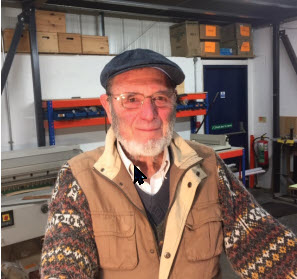Anthony W. Goodyer #10026 - UK Trustee, 2021.
Posted November 23, 2021
 I was born, two years into the second world war, in a small rural town in South Africa. My father was an
Episcopalian pastor and my mother a high school
teacher. Of interest for historians is that the last
organised “diamond rush” took place, from the town
where we lived. I was born, two years into the second world war, in a small rural town in South Africa. My father was an
Episcopalian pastor and my mother a high school
teacher. Of interest for historians is that the last
organised “diamond rush” took place, from the town
where we lived.
Following the second world war when my father
served in North Africa, my childhood and early
teens were spent at different parishes in Natal, SA.
A first encounter with timber was during the time
my family lived in an isolated village with no
electricity, railway, or tarred roads. The house was
surrounded by dense Pinus sylvestris planted in the
1920s. The house lighting was by paraffin lamps and
the gloom caused by these trees was oppressive. My
mother ordered at least some be removed. A team of
local wood cutters and sawyers turned up. They dug
a saw pit in the garden and after felling a number
of trees cut the logs into planks. An unforgettable
memory…
My father in retirement took up wood carving
perhaps because my grandfather was a carpenter in
the gold mines. When my wife Laura and I married,
we asked guests to bring “trees” for wedding
presents. At that stage our home was a small holding
on a rather bleak parcel of land initially devoid of
trees but with a good bore hole and wind pump.
Over ten years or more we planted and nurtured
these wedding trees and planted another thousand
or more of different varieties. Our challenge was
drought and fighting fires, sometimes winning
but often loosing with tears. A national highway
development persuaded us to be removed from this
spot. We found another small holding, this time with
a small seasonal river. Tree planting started again
including many indigenous and exotic varieties.
On the commercial side, I developed a system of
portable chemical toilets (unheard of in Africa in
those days where a spade was standard equipment).
I designed the toilet compartment to be built using
four standard domestic doors bolted together,
unconventional but very cheap and providing
employment. Hired out as Rent-a-loo’s the business
was successful, the construction worked and some
of the companies we set up keep going today.
Persuaded to sell the company, my wife and I then
spent time working with local communities of farm
workers, who were being evicted due to political
UK Trustee, IWCS Member 10026 - Anthony William Goodyer (born 1941)
upheaval. It was our privilege to meet Nelson Mandela
and Archbishop Desmond Tutu through this work.
Business beckoned and in conjunction with my son
Mark we developed a UV curing system, a technology
well before its time. This was responding to the need
for cheap colour material for adult literacy students.
Printed material of this type was out of their reach.
The SeriPrinter (as we called it) interested the RICOH
group in Japan sufficiently to establish a product line.
By arrangement, with my Australian partner the
SeriPrinter was manufactured in the United Kingdom,
so we moved to Whitchurch in Hampshire, where we
still live. The main take up was printers across the
United States and for many years this country was
a regular commute for our family. The SeriPrinter
continues as a legacy product for those who have not
found an alternative and my son and daughter in law
have taken over the company.
Freed up, so to speak, I have developed a novel picture
framing system called Smartframz. At this stage, in
its infancy, I have a bit more time for the interesting
study of wood which ties in with my Smartframz
development.
|